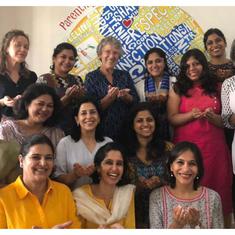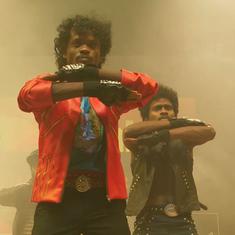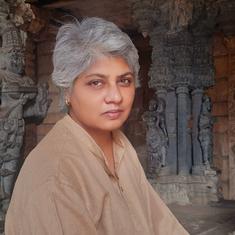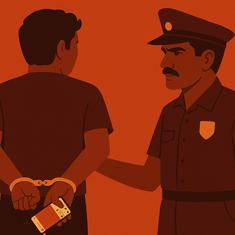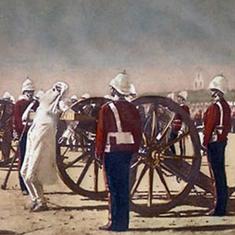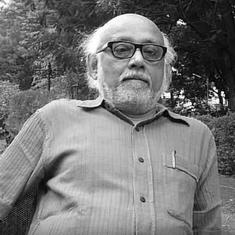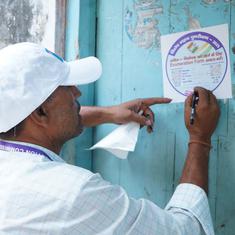Even Bongs are not really squeamish about Holi. On one hand, the colleges are co-ed and housing societies mixed, so much mingling happens; on the other, there is the whole song-and-dance (literally, song-and-dance) about Boshonto Utshob, taking a leaf out of Shantiniketan’s book. So, to conclude, I am just antisocial about Holi.
Come March, I am full of excuses. To one lot of people who invite me, kindly, to their Holi parties, I say I am allergic to colours; to others, I say bhaang induces temporary blindness in me; to a third lot I say, at the very last minute on the day of the party, that I’d have loved to come but my cat is sick. (I could have had a cat.) If they know the details of my cat situation, I tell them my husband is sick.
Instead, on a day when there is no interruption of doorbells and no chance of storming out after a fight, when the sun behaves all dippy and vain, and the shouts of children and thwacks of water balloons make you grateful for having overcome the choicelessness of childhood and, later, hostel-hood, on Holi day, the spouse and I hunker down after a late brunch to a day of reading. Or I read and he tweets. But the silence is sweet and full of springtime smells.
If you, too, are planning to stay in and read on Holi day, we have put together a list of colourful titles for you to choose from, along with their first lines to tempt you.
The Color Purple (1982), Alice Walker
One of the cult novels to have emerged out of the African-American encounter in Dixie, this epistolary novel (later made into a successful film) is set in rural Georgia of the 1930s. While it does reflect the extraordinary sorrows suffered by the protagonist, Celie, it also paints an uncommon portrait of the extraordinary sisterhood that emerges as a consequence, and provides the chief ballast against the travails of life.
You better not never tell nobody but God. It’d kill your mammy.
Dear God,
I am fourteen years old. I am I have always been a good girl. Maybe you can give me a sign letting me know what is happening to me.
Last spring after little Lucious come I heard them fussing. He was pulling on her arm. She say It too soon, Fonso, I ain’t well. Finally he leave her alone.
A Blue Hand: Allen Ginsberg and the Beats in India (2008), Deborah Baker
The Beat poets and their obsession with the search for meaning in India and the East, even as intellectuals in India looked to the West for answers, represent the quirkiest encounter in the saga of East-West dialogue, part-inter faith, part-cultural. Putting Allen Ginsberg at the centre, Baker writes a resonant multi-layered history of the Beat poets, their times, their epiphanies and their peers in India.
It was well after midnight on December 11, 1962, and Allen Ginsberg, a thirty-six-year-old poet from Newark, New Jersey, had gone off to pee for the umpteenth time. Ginsberg, along with his sometime lover Peter Orlovsky, was hurtling north in a third-class carriage on the Doon Express. The train had started at Howrah station in Calcutta and would deposit the pair sometime the following day in Benares. Ginsberg had been suffering from kidney ailments for years.
I, Lalla – The Poems of Lal Děd. Translated by Ranjit Hoskote (2011)
The 14th century mystic Lal Děd, a practitioner of Kashmir Shaivism, and arguably influenced by a range of traditions as discrete as Tantra, Yoga, Buddhism and Sufism, is a poet whose work, in the words of Hoskote, ‘strike us like brief and blinding bursts of light: epiphanic, provocative, they shuttle between the vulnerability of doubt and the assurance of an insight gained through resilience and reflection’. In a masterful new translation, Hoskote has chipped away a century of Victorian inflections in English translations of Lalla’s work to reveal a fundament of spectacular raw power.
One shrine to the next, the hermit can’t stop for breath.
Soul, get this! You should have looked in the mirror.
Going on a pilgrimage is like falling in love
with the greenness of faraway grass.
The Book of Gold Leaves (2014), Mirza Waheed
A heartbreaking story of two lovers, Faiz and Roohi, in Kashmir of the 1990s. As the shadows of strife lengthen and the rumble of war sounds in the distance, this is a novel with an exciting cast of characters and a fine turn of prose.
Faiz
The light-bulb in the room is of low voltage. A pale, sad light – they cannot afford high-voltage lamps for each of the eighteen rooms – is, has been for more than a year, his sole companion as he paints deer, lions, cypresses, tall rose bushes, chinar leaves, Mughal princes on hunting trips with their high elephants, on the pencil boxes that Mustafa Peer, the handicrafts middleman, wants finished and delivered in a month. Five hundred boxes in thirty days. Eight rupees per piece. The slender boxes will go to a buyer in Delhi who will them ship them to an art & craft dealer in Calgary in Canada, 9.99 dollars apiece at Christmas. Faiz, smoking his Four Square Tens in halves, melts his fingers into each figure. He could simply buy his own lamps but he has come to love this peculiar pastel glow. Also, he does not want his to be the only room with bright light.
The Silver Linings Playbook (2010), Matthew Quick
Now made into a widely acclaimed film, the novel is the epic story of Pat, a former history teacher, who, after a stint in a psychiatric hospital, moves back in with his parents, determined to win back his estranged wife Nikki. Coping with an eccentric therapist – who seems to be recommending adultery – and the deeply odd Tiffany, who seems to be pursuing him, Pat’s focus on silver linings is exactly the sort of soulful heartwarming stuff the doctor ordered in a season of flu and blue.
An Infinite Amount of Days Until My Inevitable Reunion With Nikki
I don’t have to look up to know Mom is making another surprise visit. Her toenails are always pink during the summer months, and I recognize the flower design imprinted on her leather sandals; it’s what Mom purchased the last time she signed me out of the bad place and took me to the mall.
White Man/ Yellow Man, Shusaku Endo. Translated by Teruyo Shimizu (1967)
One of the most celebrated Japanese writers, Shusaku Endo (1923 – 1996) was converted to Catholicism at the age of eleven, and spent time in a seminary in France. Obsessed with the notion of identity, and how it shapes perspective and character, Endo’s novels probe at the deepest motifs of culture with a view to forge an alternative account of the self and the other. White Man/ Yellow Man is a composite of two novellas set against the backdrop of the Second World War, one in France and one in Japan.
White Man
January 28, 1942. I am going to make a record of this. The Allies are already advancing on Valence. They will arrive in Lyon as early as tomorrow or the day after tomorrow. The Nazis know best that they are bound to be defeated.
At this very moment, as I write this, the windows of my room are violently shaking.
Anne of Green Gables (1908) by LM Montgomery
An all-time children’s classic, Anne of Green Gables is the unforgettable story of the book-hungry orphan Anne and her (mis)adventures in her adoptive home and village, as well as her friends and enemies, the chief of which becomes later, rather charmingly, her beau. I do not remember every little detail about the book, but I do remember how I had worshipped it one long winter vacation. If you haven’t read it, do. If you have, well then, you’d be surprised how much you’ll love re-reading it.
Mrs Rachel Lynde Is Surprised
Mrs Rachel Lynde lived just where the Avonlea main road dipped down into a little hollow, fringed with alders and ladies’ eardrops and traversed by a brook that had its source away back in the woods of the old Cuthbert place; it was reputed to be an intricate, headlong brook in its earlier course through those woods, with dark secrets of pool and cascade; but by the time it reached Lynde’s Hollow it was a quiet, well-conducted little stream, for not even a brook could run past Mrs Rachel Lynde’s door without due regard for decency and decorum…
Drunk Tank Pink: The Subconscious Forces that Shape How We Think, Feel and Behave (2014), Adam Alter
Drunk Tank Pink is a peculiar shade of pink. In 1979, it was discovered by psychologists that the exact shade has an extraordinary effect: if one stares at it for two minutes, one dramatically weakens in strength. One of those clever interesting books on popular psychology (Blink by Malcolm Gladwell and Stumbling Upon Happiness by Daniel Gilbert come to mind), Drunk Tank Pink is a fascinating account of our minds, its corners, and the strange things it does often without our knowing.
The academic journal Orthomolecular Psychiatry began its final issue of 1979 with a classic paper that kindled the imaginations of prison wardens, sports coaches and exasperated parents alike.
Oranges Are the Not the Only Fruit (1985), Jeanette Winterson
The debut work of fiction of Jeanette Winterson, one of brightest, sparkiest and most celebrated of feminist writers of contemporary times, is an eccentric and deeply moving bildungsroman based loosely upon her own experiences. Jeanette is an orphan adopted by strict Pentecostal missionaries who bring her up to be one too. This plan dedicated to God’s Work is upturned when Jeanette’s adolescent sexual stirrings contest the mainstream so cleanly. Written in spare, steely prose, it is Winterson’s dry humour that cuts through the scabbard of her writing with a certain remarkable felicity.
Genesis
Like most people I lived for a long time with my mother and father. My father liked to watch the wrestling, my mother liked to wrestle; it didn’t matter what. She was in the white corner and that was that.
(This piece is dedicated to my extremely persuasive friend Neelini who threw the best – and only – Holi party I ever attended. I expect this Holi she has her new Italian family singing 'Ore Grihobashi, khol daar kho-o-o-l, laaglo be dol' clad in a scenic yellow. I miss her.)
Devapriya Roy is the author of The Vague Woman’s Handbook and The Weight Loss Club. Her new book The Heat and Dust Project, co-written with husband Saurav Jha, is the story of an eccentric journey through India on a very very tight budget.


